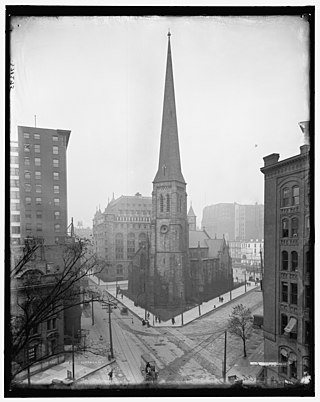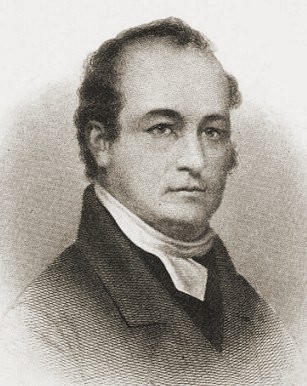
The Erie Canal is a historic canal in upstate New York that runs east–west between the Hudson River and Lake Erie. Completed in 1825, the canal was the first navigable waterway connecting the Atlantic Ocean to the Great Lakes, vastly reducing the costs of transporting people and goods across the Appalachians. In effect, the canal accelerated the settlement of the Great Lakes region, the westward expansion of the United States, and the economic ascendancy of New York State. It has been called "The Nation's First Superhighway."

Orleans County is a county in the western part of the U.S. state of New York. As of the 2020 census, the population was 40,343. The county seat is Albion. The county received its name at the insistence of Nehemiah Ingersoll though historians are unsure how the name was selected. The two competing theories are that it was named to honor the French Royal House of Orleans or that it was to honor Andrew Jackson's victory in New Orleans.

Brockport is a village in the Town of Sweden, with two tiny portions in the Town of Clarkson, in Monroe County, New York, United States. The population was 7,104 at the 2020 U.S. Census. The name is derived from Heil Brockway, an early settler. It is also home to SUNY Brockport.

Medina is a village in the Towns of Shelby and Ridgeway in Orleans County, New York, United States. It is located approximately 10 miles south of Lake Ontario. The population was 6,065 at the 2010 census, making it the county's most populous municipality. The village was named by its surveyor, Ebenezer Mix. It is part of the Rochester Metropolitan Statistical Area. The Medina zip code, 14103, encompasses the village of Medina and the surrounding towns of Ridgeway and Shelby. The United States Census Bureau estimates the 2017 population of this area to be 17,234.

Albion is a village in Orleans County, New York, United States. The population was 5,637 as of the 2020 census, down 419 from the 2010 census. The village is centrally located in the county, and is partly within the towns of both Albion and Gaines. It is the county seat of Orleans County and is about 30 miles (48 km) west/northwest of Rochester. Albion is part of the Rochester metropolitan area.

Western New York (WNY) is the westernmost region of the U.S. state of New York. The eastern boundary of the region is not consistently defined by state agencies or those who call themselves "Western New Yorkers". Almost all sources agree WNY includes the cities of Buffalo, Niagara Falls, Jamestown, and the surrounding suburbs, as well as the outlying rural areas of the Great Lakes lowlands and Niagara Frontier, and Chautauqua-Alleghany. Many would also place Rochester and the Genesee Valley in the region, while some would also include the western Finger Lakes within the region. Others would describe the latter three areas as being in a separate Finger Lakes region.

The Falls Road Railroad is a Class III short line railroad owned by Genesee Valley Transportation (GVT). The railroad operates in Niagara, Orleans, and Monroe counties in New York.
The Buffalo and Niagara Falls Railroad was a part of the New York Central Railroad system, connecting Buffalo, New York to Niagara Falls. It is still used by CSX for freight and Amtrak for passenger service.

New York State Route 31 (NY 31) is a state highway that extends for 208.74 miles (335.93 km) across western and central New York in the United States. The western terminus of the route is at an intersection with NY 104 in the city of Niagara Falls. Its eastern terminus is at a traffic circle with NY 26 in Vernon Center, a hamlet within the town of Vernon. Over its routing, NY 31 spans 10 counties and indirectly connects three major urban areas in Upstate New York: Buffalo–Niagara Falls, Rochester, and Syracuse. The route is one of the longest routes in New York State, paralleling two similarly lengthy routes, NY 104 to the north and NY 5 to the south, as well as the Erie Canal, as it proceeds east.

New York State Route 31A (NY 31A) is an east–west state highway located in the western part of New York in the United States. It serves as a southerly alternate route of NY 31 from the western part of Orleans County to the far western part of Monroe County. It diverges from NY 31 south of the village of Medina and parallels NY 31 eastward until it reconnects to its parent route southwest of the village of Brockport. While NY 31 passes through the villages of Medina, Albion, and Holley, NY 31A bypasses all three, serving sparsely populated areas to their south instead. The route intersects NY 98 south of Albion and NY 237 in Clarendon.

St. Paul's Cathedral is the cathedral of the Episcopal Diocese of Western New York and a landmark of downtown Buffalo, New York. The church sits on a triangular lot bounded by Church St., Pearl St., Erie St., and Main St. It was built in 1849-51 to a design by Richard Upjohn, and was believed by him to be his finest work. Its interior was gutted by fire in 1888, and was redesigned thereafter by Robert W. Gibson, and it was designated a National Historic Landmark in 1987 for its architecture.

Myron Holley was an American politician who played a major role in the creation of the Erie Canal. In 1816, he was appointed to the five-person Erie Canal Commission, which had the task of organizing and supervising the canal's construction. As one of two full-time and salaried members of the commission, he was its treasurer and the supervisor for the construction of the canal's main route.

The Main Street Historic District in Medina, New York, United States, is the downtown commercial core of the village. It is a 12-acre (4.9 ha) area stretching south along Main Street from the Erie Canal to the railroad tracks.

Saint Michael's of Rochester Roman Catholic church located in Rochester, New York. Standing at 246 feet (75 m), it is the 10th tallest building in Rochester. It is a currently active parish church within the Roman Catholic Diocese of Rochester, Monroe Central Deanery, and is one of three churches that make up the Saint Francis Xavier Cabrini Parish, alongside Church of the Annunciation, and Our Lady of the Americas Church.

The North Main–Bank Streets Historic District is located along those streets in Albion, New York, United States. It is one of two historic districts in the village, comprising the commercial core of the village, developed during its years as a major stop on the Erie Canal. A portion of the canal, now the New York State Barge Canal, and two of its bridges are within the district.

The Orleans County Courthouse Historic District is one of two located in downtown Albion, New York, United States. Centered on Courthouse Square, it includes many significant buildings in the village, such as its post office and churches from seven different denominations, one of which is the tallest structure in the county. Many buildings are the work of local architect William V.N. Barlow, with contributions from Solon Spencer Beman and Andrew Jackson Warner. They run the range of architectural styles from the era in which the district developed, from Federal to Colonial Revival.

First Presbyterian Church is a historic Presbyterian church located at Rochester in Monroe County, New York. It is a Gothic Revival–style edifice designed in 1871 by Rochester architect Andrew Jackson Warner. It is built of Albion sandstone and trimmed with white Medina sandstone. It features a single stone bell tower and spire at the northeast corner beside the main entrance. It was the third home for Rochester's oldest congregation. It is now home to the Central Church of Christ.

The Old Stone Warehouse in Rochester, New York is an historic warehouse building. It was built in 1822 and is a four-story, trapezoidal building with six-story addition built of Medina sandstone. It was built by Myron Holley and is located on the Erie Canal. Throughout the 19th century it was used for multiple purposes: as a foundry, a storage warehouse, a tile pottery production facility, and a brewery.

The Pullman Memorial Universalist Church of Albion, New York was constructed in 1894 as a memorial to the parents of inventor and industrialist George Mortimer Pullman. The structure, built of pink Medina sandstone and featuring fifty-six Tiffany stained glass windows and a Johnson pipe organ, is in the Orleans County Courthouse National Historic District. The building has been in constant use since its opening; the congregation affiliating with the Unitarian Universalist Association in 1961 but keeping its historic name.
The Rochester, Lockport and Buffalo Railroad was an electric interurban railway that was constructed between Rochester, New York, and Lockport, New York, connecting to the International Railway Co. at Lockport for service into Buffalo. Opened in 1909 as the Buffalo, Lockport and Rochester Railway, the route followed the Erie Canal and the New York Central Railroad's Falls Road branch for most of its length. For a brief period of time, the railway was part of the Beebe Syndicate of affiliated interurban railways stretching from Syracuse to Buffalo. Entering receivership in 1917, it was reorganized as the Rochester, Lockport and Buffalo Railroad in 1919. After years of struggling with declining revenue during the Depression years, the railway's last day of service was April 30, 1931.




















